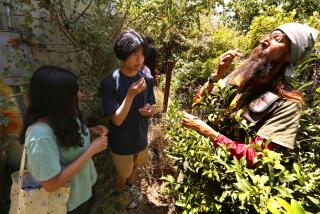Best Schools Share Path to Success
High schools that succeed in boosting achievement of disadvantaged students engage in many of the same practices, including assigning the best teachers to the neediest classes, according to two reports released Wednesday.
The Education Trust, which focuses on ways to close the achievement gap between low-income minority students and others, spent the last academic year scrutinizing schools around the country to find out what the better ones were doing to make a difference.
Its first report, “Gaining Traction, Gaining Ground,” identified four so-called high-impact schools -- Los Altos High in Hacienda Heights and three North Carolina schools -- and compared them with demographically similar campuses that were making only average strides with their struggling students.
High-impact schools, while not the strongest performers in all areas, have been able to make better-than-expected gains with their students, including large numbers of minority and low-income youths, researchers said.
The second report, “The Power to Change,” examined the practices at three high-performing schools in Massachusetts, New York and Washington state.
Kati Haycock, Education Trust director, said at a Washington, D.C., news conference that the study’s goal was to identify methods that other schools could use to improve their programs and boost achievement.
“We know that there are far too few high schools that are helping all children succeed, regardless of their skin color or neighborhood,” Haycock said. “But this research shows us that real improvement can occur.”
High-impact schools tend to differ from typical -- or so-called average impact -- high schools in several important ways, researchers found.
They interviewed faculty, observed classrooms and read student transcripts and school handbooks.
Among the elements that made these schools successful, according to the report:
* Principals are more likely to match talented teachers with students who need them most, instead of following a more common practice of assigning department heads and other experienced teachers to advanced or honors classes.
* Support for new teachers tends to be more thorough and includes such techniques as providing model lesson plans and teaming a beginner with an experienced colleague.
* Early intervention programs -- often mandatory -- are used to help students before they fail and become discouraged; requiring summer school or after-school tutoring is common.
* Academic support services for struggling students keep them in current-grade-level classes while they are catching up; in more typical schools, such students are put into remedial classes, reducing their chances of meeting rigorous graduation requirements on time.
* The focus is on preparing students for life beyond high school, not just on getting students to graduation day; academic expectations are high -- often including a college-prep curriculum for all students -- and consistently communicated to parents and students.
Researchers found that the average-impact schools often focus on behavior rules in their student handbooks.
High-impact schools, however, are more likely to emphasize academic programs and expectations in handbooks and in other communications to parents.
The more successful schools emphasize reading for at-risk students and use test data to monitor student progress and adjust teaching methods.
They also try to place struggling students in the smallest classes and ensure that teachers, counselors and others have time to plan together.
At Los Altos High, in the Hacienda La Puente Unified School District, incoming ninth-graders who are behind in math or English are enrolled in summer school.
Principal William F. Roberts IV said any resistant parents are strongly counseled about the program’s benefits. If they refuse, their children receive extra tutoring during the school year.
Los Altos has lengthened the school day and matched its strongest teachers with students who need them most, but Roberts said the school still “has a long way to go. We’re on a real journey. Challenging the status quo is a difficult thing.”
More to Read
Sign up for Essential California
The most important California stories and recommendations in your inbox every morning.
You may occasionally receive promotional content from the Los Angeles Times.










